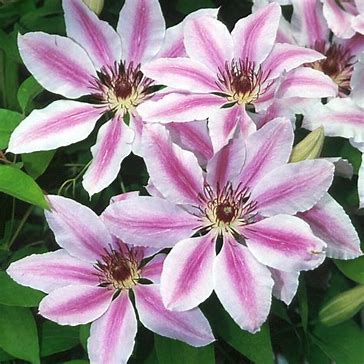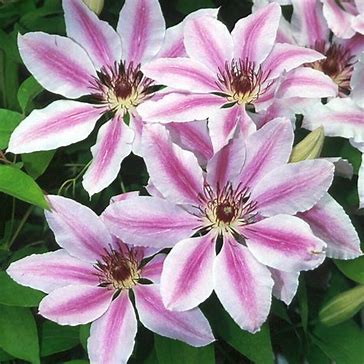Riverdene Garden Center
Nelly Moser Clematis
Nelly Moser Clematis
Couldn't load pickup availability
Clematis ‘Nelly Moser’
Nelly Moser is a cold-hardy, vigorous, large-flowered clematis known for its stunning pale pink flowers with a deep pink central stripe. This deciduous climbing vine produces two flushes of blooms—one in late spring to early summer and another in late summer to early fall. It is an excellent choice for trellises, fences, arbors, and pergolas, adding vertical interest to Southwest Saskatchewan gardens.
Planting & Growing Conditions
- Hardiness Zone: 4-9 (cold-hardy and suitable for prairie climates with protection in Zone 3)
- Mature Size: 6-10 feet tall, 3-4 feet wide
- Growth Rate: Moderate to fast
-
Sunlight Needs:
- Full sun to partial shade (best flowering with 6+ hours of direct sun)
- Prefers afternoon shade to prevent fading of flower colors
-
Soil Requirements:
- Prefers moist, well-drained, loamy soil
- Tolerates slightly acidic to neutral soil (pH 6.0-7.5)
- Avoid waterlogged soil, as clematis dislikes wet feet
- Spacing: 3-4 feet apart for optimal air circulation
Watering & Maintenance
-
Young Plants (First Year):
- Water deeply 2-3 times per week to establish roots
-
Established Vines:
- Requires consistent moisture, especially in dry conditions
- Water weekly during hot summers
-
Mulching:
- Apply a 2-3 inch layer of mulch around the base to retain moisture and keep roots cool
Fertilizing
- First Year: No fertilizer needed—focus on root establishment
-
Mature Plants:
- Apply a balanced fertilizer (e.g., 10-10-10) in early spring
- Supplement with bone meal or compost to promote strong root growth
- Avoid excessive nitrogen, which promotes leafy growth over flowers
Pruning & Maintenance
Nelly Moser belongs to Pruning Group 2, which means it blooms on both old and new wood.
- Best Time to Prune: Late winter to early spring, before new growth begins
-
How to Prune:
- Step 1: Remove dead, damaged, or weak stems
- Step 2: In early spring, lightly prune to shape the vine and encourage branching
- Step 3: After the first bloom (mid-summer), trim back spent flowers to encourage a second flush of blooms
Flowers, Foliage & Seasonal Interest
- Bloom Time: Late spring to early summer, with a second bloom in late summer
-
Flower Color:
- Soft pink with a deep magenta central stripe
- Large flowers (6-8 inches wide)
- Fragrance: Mild to none
-
Foliage:
- Spring & Summer: Medium green, deciduous leaves
- Fall: Leaves turn yellow before dropping
Pest & Disease Management
Resistant to: Deer, rabbits, and most pests
Common Pests:
-
Aphids – Can cause leaf curling
- Solution: Spray with insecticidal soap or introduce ladybugs
-
Slugs & Snails – Can chew on new shoots
- Solution: Use crushed eggshells or diatomaceous earth around the base
Common Diseases:
-
Clematis Wilt (Fungal Disease) – Causes sudden wilting of stems
- Solution: Remove affected stems and ensure good air circulation
-
Powdery Mildew – White fungal coating on leaves in humid conditions
- Solution: Improve airflow and apply an organic fungicide if needed
Winter Protection
- Cold-Hardy to Zone 4, but may require winter mulch protection in Zone 3
-
Mulching:
- Apply 4 inches of mulch around the base in late fall
- Avoid heavy pruning in fall, as this can remove buds for next season’s blooms
Landscape Uses
Perfect for trellises, fences, arbors, and pergolas
Great for cottage gardens and pollinator-friendly landscapes
Attracts bees and butterflies
Compact enough for small spaces and containers
Beautiful when combined with climbing roses or shrubs
Companion Planting Ideas:
- Climbing Roses – For a romantic vertical display
- Honeysuckle – Complements clematis with fragrant blooms
- Hydrangeas – Adds a lush, soft backdrop
- Evergreens (Boxwood, Juniper, or Yew) – Provides contrast to clematis vines
- Daylilies & Hostas – Help shade clematis roots while adding color
Additional Notes:
- Nelly Moser is one of the most reliable and long-blooming clematis varieties
- Lifespan: 20+ years with proper care
- Great for beginners as it is easy to grow and maintain
Photo courtesy of plantaddicts.com
Share


